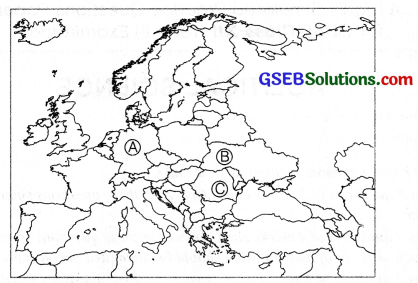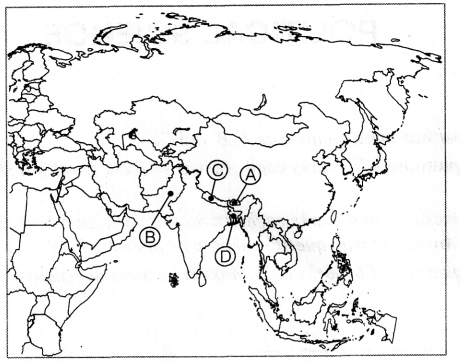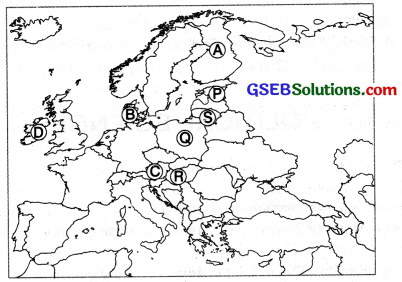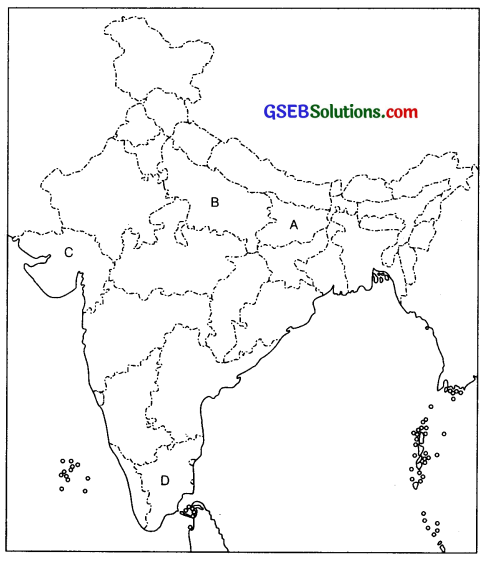Students can access the CBSE Sample Papers for Class 12 Political Science with Solutions and marking scheme Term 2 Set 5 will help students in understanding the difficulty level of the exam.
CBSE Sample Papers for Class 12 Political Science Term 2 Set 5 with Solutions
Time allowed: 2 Hours
Maximum Marks: 40
General Instructions:
- The question paper has three sections as A,B and C.
- Section A has 8 questions of 2 marks each. Answer to these questions should be completed within 50 words each.
- Section B has 3 questions of 4 marks each. Answer to these questions should be completed within 100 words each. Answer of map question should be attempted accordingly.
- Section C has 2 question of 6 marks each. Answer to these questions should be completed within 170 words each.
Section A
Question 1.
What do you know about Bangkok Declaration? (2)
Or
Why European Union is considered as highly influential regional organisation?
Answer:
Bangkok Declaration is also known as ASEAN Declaration. Association of South-East Asian Nations (ASEAN) was established in 1967 by its founding countries. The founding members of ASEAN are Indonesia, Malaysia, Philippines, Singapore and Thailand.
Over the years, Brunei Darussalam, Vietnam, Lao PDR, Myanmar and Combodia also joined ASEAN taking its strength to ten members.
![]()
Therefore, ASEAN is a regional organisation which was established to promote political and social stability amid rising tensions among the Asia-Pacific’s post colonial states. The motto of ASEAN is One Vision, One Identity, One Community.
Question 2.
List three challenges to democracy in Nepal? (2)
Answer:
The three challenges to democracy in Nepal are as explained below:
- The Maoists who believe in armed insurrection against the monarch and the ruling elite, have now asked for the constitution to include the radical programmes of social and economic restructuring.
- Some sections think that a nominal monarchy is necessary in Nepal to retain its link with the past.
- Differences between the Maoists and the parties in the Seven Parties Alliance are also challenge to the democracy in Nepal as they view India with suspicion of its role in Nepal future.
Question 3.
Discuss the different types of political system in South Asia? (2)
Answer:
The political system in South Asia do not have similarities for reasons as mentioned below:
- There is democracy in India and Sri Lanka. Both the countries have remained democratic through out their existence since independence.
- Pakistan and Bangladesh have experienced both civilian and military rulers.
- There was a constitutional monarchy in Nepal but in 2008 popular uprising led to the restoration of democracy. It reduced the king to a nominal position. Now the king has also been removed.
- Bhutan is still a monarchy but the king has initiated plans for its transition to multi-party democracy.
- Maldives was a Sultanate till 1968 when it was transformed into a republic with a Presidential form of government. (Any two points)
![]()
Question 4.
Describe the internal conflict of Bangladesh? (2)
Answer:
The Constitution of Bangladesh was drafted with the faith in secularism, democracy and socialism. In 1975, the Constitution was amended to shift from the Parliamentary to Presidential form of government by Sheikh Mujib Ur Rahman.
Through this he abolished all the political parties except his own Awami League, which further led to conflicts and tensions in the country.
Sheikh Mujib was assassinated in a military uprising in 1975 and Ziaur Rahman, formed his own Bangladesh National Party. He won the elections of 1979 and was also assassinated. Then, the military took over under Lt. General HM Ershad.
The people of Bangladesh stood up for the demand of democracy. Some political activity on a limited scale was allowed by Ershad and in 1990 mass public protests led his government to step down. Since, the elections in 1991, representative democracy has been working in Bangladesh.
Question 5.
What is alliance politics? How has it influenced the Indian politics? (2)
Answer:
Alliance politics is when a particular party joins another party and forms the government, keeping its own interests. It influence Indian politics in following ways:
- Its was a beginning of an era of multi-party system as no single party could secure a clear majority.
- Emergence of powerful parties groups and movements which represented Dalits and Other Backward Classes.
- The newly emerged groups played an important role in running the United Front Government of 1996.
- In 1996 elections, the BJP emerged as the largest party and was united to form government, but it failed to get the support of other parties to secure a majority in the Lok Sabha. (Any two points)
Question 6.
What were the effects of Gujarat riots? (2)
Answer:
In February 2002, four bogies of Sabarmati Express carrying karsewaks from Ayodhya were set on fire in Godhra killing 58 people. This incident is known as Gujarat riot or Godhra incident. The effects of Godhra incident were as described below:
1. There was large scale violence against Muslims in many parts of Gujarat because it was suspected that the Muslims were responsible for this incident. The violence continued for about a month.
2. As a result of violence in the state, the Election Commission postponed the Assembly elections.
3. This incidence proved that sometimes the government machinery becomes susceptible to sectarian passions.
4. Such instances warn us that using religious sentiments for political purposes is dangerous and poses a threat to democratic politics.
![]()
Question 7.
What are the lesson learnt from the Emergency? (2)
Answer:
The lesson learnt from the emergency are as follows.
1. It is extremely difficult to remove democracy from India.
2. It brought out some ambiguities regarding the emergency provision in the Constitution that have been rectified since. Now, ‘Internal’ emergency can be proclaimed only on the grounds of ‘armed rebellion’ and it is necessary that the advice to the President to proclaim emergency must be given in writing by the Council of Minister.
3. The emergency made everyone more aware of the value of civil liberties. The Courts too, have taken an active role after the emergency in protecting the civil liberties of the individuals.
4. The actual implementation of the emergency rule took place through the police and the
administration. These institutions could not function independently. They were turned into political instruments of the ruling party. (Any two points)
Question 8.
State objectives of BRICS. (2)
Answer:
The objectives of BRICS are summarised below:
1. The BRICS seeks to deepen broaden and intensify cooperation within the grouping and among the individual countries for more sustainable, equitable and mutually beneficial development.
2. BRICS is emerging as a new and promising political-diplomatic entity with diverse. Objectives, far beyond the original objective of reforming global financial institutions.
Section B
Question 9.
What is Euro- Skepticism? What were the military influence of European Union? (4)
Answer:
Euro- Skepticism refers to a European political doctrine that advocated disengagement from the European Union. Euro- Skepticism is evident in some parts of Europe about the Europe’s
integrationist agenda.
For Examples, UK’s former PM Margaret Thatcher kept UK out of the European market. Denmark and Sweden resisted Maastricht Treaty and the adoption of Euro. The military influence of European . Union is discussed below.
![]()
1. EU’s combined armed forces are the second largest in the world and comes second after US in defence expenditure.
2. Britain and France as EU members also possess nuclear arsenal of 550 nuclear warheads. It is also the world’s second most important source of space and communication technology.
3. EU is able to intervene in economic, political and social areas. But in many areas member states have their own foreign and defence policies that are often at odds with each other. For instance, Britain was by the side of US during the Iraq invasion whereas Germany and France oppose the American policy.
Question 10.
What was Mandal Commission? Did it try to solve the problems of Other Backward Classes? State any two arguments in support of your answer. (4)
Answer:
The Mandal Commission under the Chairmanship of Bindeshwari Prasad Mandal set up in 1978 to investigate the extent of educational and social backwardness among various sections of society and recommended ways to identify these classes. The Mandal Commission gave its recommendations in 1980.
- The Commission advised that ‘backward classes’ should be understood to mean ‘backward castes’, since many castes, other than the SCs, were also treated as low in caste hierarchy.
- Reservation 27% seats in educational institutions and government jobs for these groups.
- It recommended land reform to improve the conditions of the OBCs.
- Hence, Mandal Commission made recommendations in economic and occupational structures. The Government of India accepted recommendations in 1990
- 27% jobs reservations has been made in Central and State government.
- Many welfare schemes have also been launched as Swarnima National Backward Classes Finance and Development Corporation.
Question 11.
On the political map of India mark (4)
(i) Two states where Congress was not in power at some point during 1952-67.
(ii) Two states where the Congress remained in power through this period.
Answer:
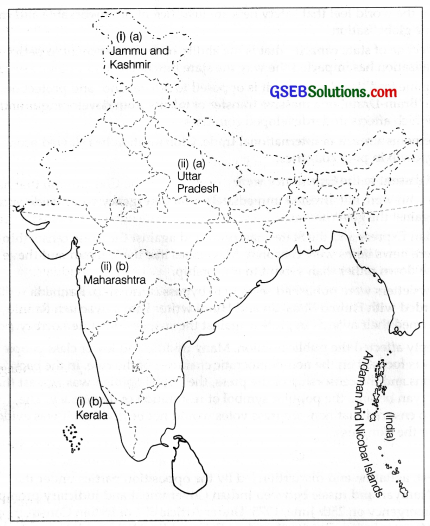
Section C
Question 12.
“Globalisation has occurred in different parts of the world”. How far it has affect India? Discuss. (6)
Or
Explain the issues because of which globalisation is criticised all over the world?
Answer:
Globalisation has occurred in different parts of the world at different times in history. Flows of wealth, commodities, ideas and people can be traced back several countries in Indian history. Globalisation has affected India economically, socially and culturally.
India removed restrictions on imports of goods after adopting New Economic Policy in 1991; which also boosted the investers to invest in India.
Foreign Direct Investment has increased the production of goods and services and it has also enhanced Foreign Exchange Reserves.
- The European and USA culture spreaded in India after adoption of globalisation which bring about changes in food habits and dressing style. Families are converting from joint to nuclear.
- Information technology and space technology have been enhanced after globalisation.
- India have been also participating in trade and commerce with other nations. India plays a leadership role at many other places.
However, in India resistance to globalisation has come from various quarters like Trade Unions of industrial work force and through social movements.There have been left-wing protest to economic liberalisation voiced through political parties as well as through forums like Indian Social Forum. While it is too early to assess how beneficial this has been for India, the final test is ensuring that the advantages of progress are shared so that everyone benefits.
Or
Issues because of which globalisation is criticised all over the world are as follows:
- Globalisation has been criticised for benefiting those who are already large and in power at the risk and growing vulnerability of the countries’ indigenous population.
- Some economists have described economic globalisation as re-colonisation of the world.
- Many movements all over the world feel that safety nets are insufficient or unworkable and called for halt to forced economic globalisation.
- Globalisation results in decline of state capacity that is the ability of the government to perform tasks gets reduced. Globalisation has impacted the way the state functions.
- Globalisation will undermine traditional cultures; it is opposed to self-reliance and protectionism. Globalisation generates a ‘Brain-Drain’ or a massive transfer of talents from developing countries to developed countries, which affects underdeveloped countries.
- Poor countries have suffered as a result of international trade. Globalisation has slowed economic progress and industrial growth in poor countries.
![]()
Question 13.
Highlight the acts of dissent and resistance to the Emergency imposed in 1975. In your opinion, how did these acts affect the public opinion? (6)
Or
Why the Government of India has imposed the National Emergency in 1975?
Answer:
Some acts of resistance and dissent to the Emergency were:
1. Several political workers who were not arrested immediately after emergency went ‘underground’ and organised protests against the government.
2. Newspapers like the Indian Express and the Statesman protested against the press censorship by leaving blank spaces where news items were censored. Magazines like the Seminar and the Mainstream chose to close down rather than submit to censorship.
3. Many pamphlets and newsletters were published secretly to bypass censorship. Kannada writer Shivarama Karanth, awarded with Padma Bhushan and Hindi writer Famishwamath Renu awarded Padma Shri returned their awards in protest against the suspension of democracy.
These acts of resistance deeply affected the public opinion. Many middle and lower class people came to believe that emergency was focused on the non-democratic character of the rule. In the backdrop of arrest of thousands of persons and the censorship of the press, the public opinion was against the Congress.
Jayaprakash Narayan became the popular symbol of restoration of democracy. The formation of Janta Party also ensured that non-congress votes would not be divided. It was evident that the going was tough for the Congress.
Or
The massive frequent protest, agitation and disruption led by the opposition parties under the leadership of Jayaprakash Narayan and tussle between Indian Government and Judiciary prompted government to declare of Emergency on 25th June, 1975.
Under Article 352 of Indian Constitution upon the advice by Prime Minister Indira Gandhi President Fakhruddin Ali Ahmed declared a state of emergency.
![]()
Government justified the declaration of Emergency on the following reasons
- There was a threat of internal disturbances which caused serious crisis which made declarations of Emergency necessary.
- In democracy, opposition parties must allow the elected ruling party to govern according to its policies. Frequent agitation, protest and disruption detailed government and democracy as well.
- Extra-Parliamentary polities targeting Government leads to instability and divert the focus of administration of law and order from development to maintenance.
